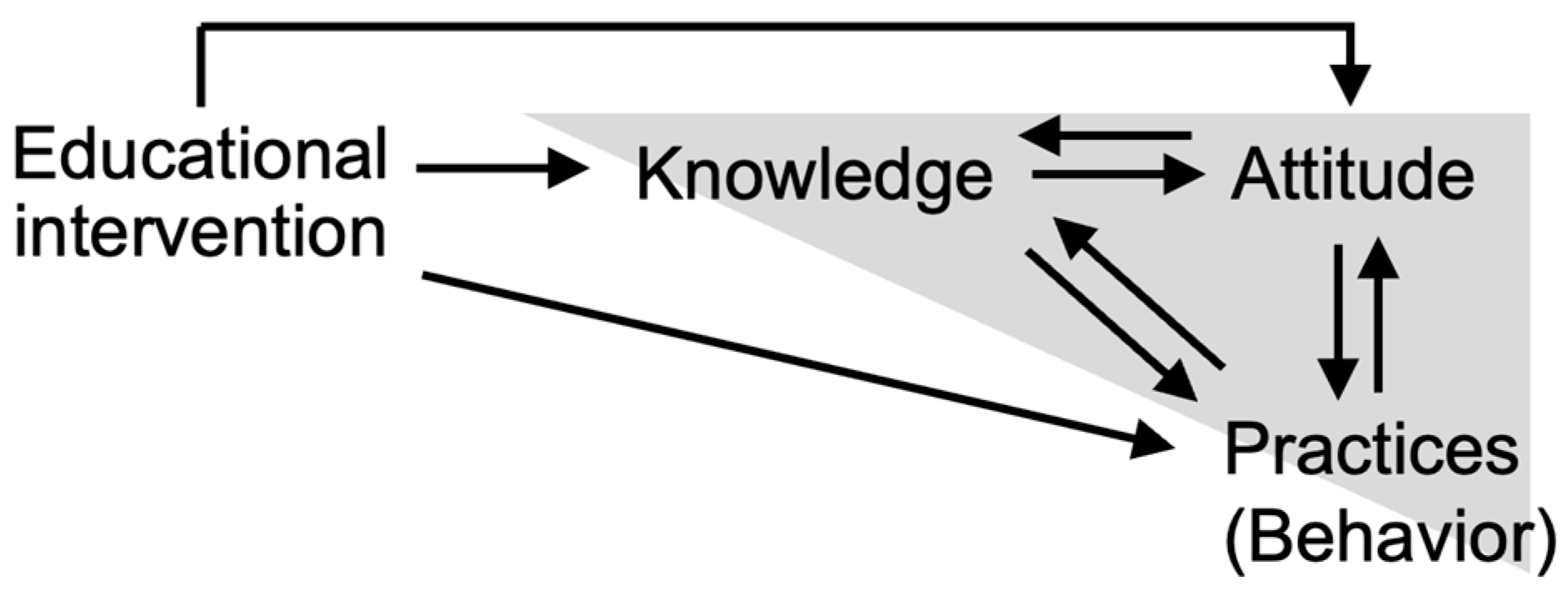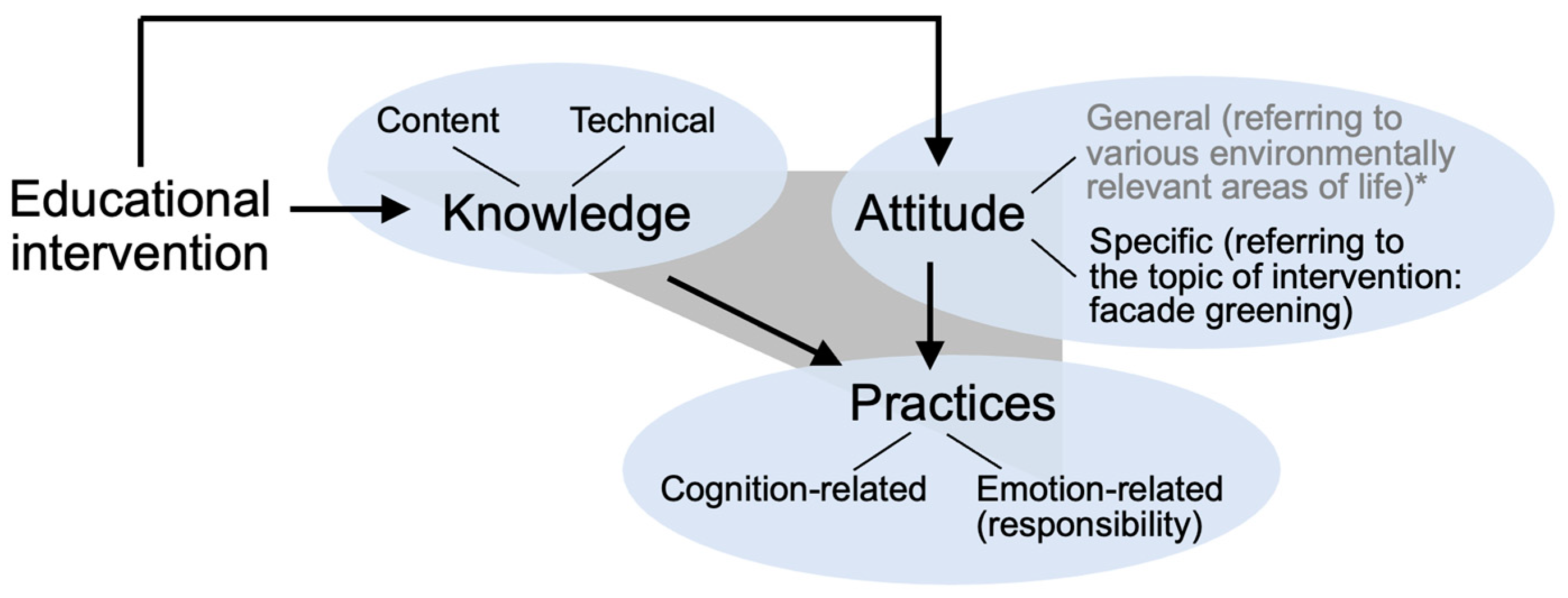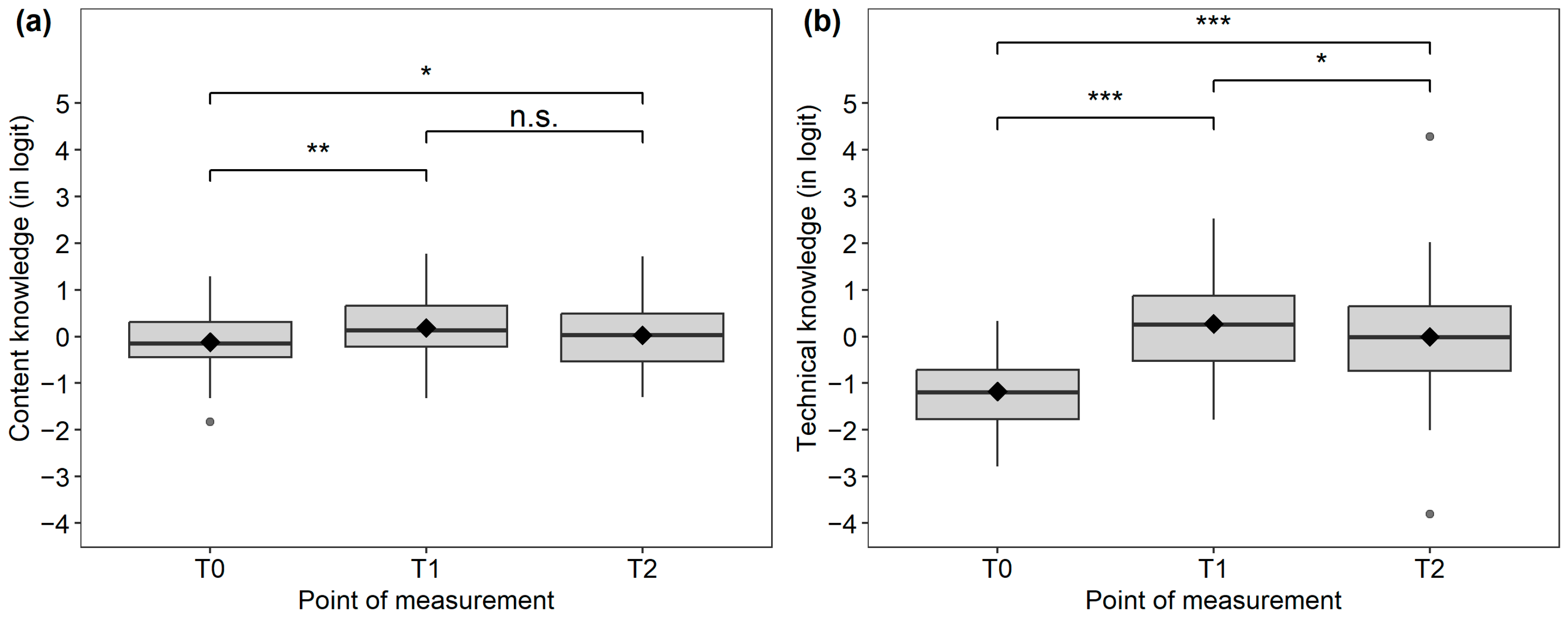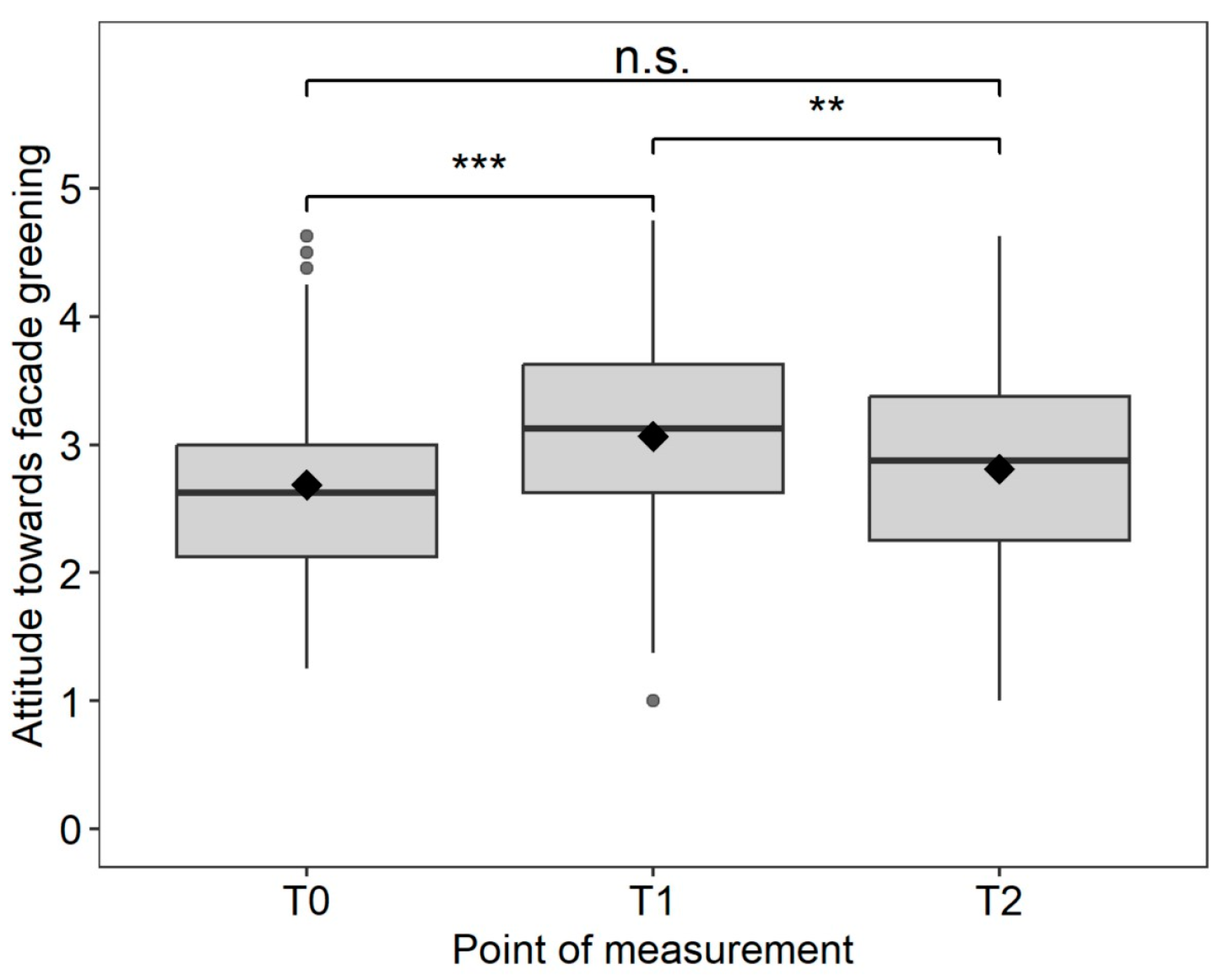Sustainability Education Through Green Facades: Effects of a Short-Term Intervention on Environmental Knowledge, Attitude, and Practices
Abstract
1. Introduction
2. Theoretical Background
2.1. Green Facades, an Exemplary Topic for Teaching About Sustainability
2.1.1. Content-Related Reasons for Teaching About Green Facades
- Goal no. 3: good health and well-being;
- Goal no. 11: sustainable cities and communities;
- Goal no. 13: climate action;
- Goal no. 15: life on land.
2.1.2. Educational Reasons for Teaching About Green Facades
- Exemplarity: Green facades are an example to demonstrate the multiple positive environmental effects of greening measures in general (parks, hedges, etc.). In addition, green facades support thinking in another spatial dimension, namely not only in the horizontal but also in the vertical, which may also be relevant for plant cultivation;
- Students’ current life meaning: Green facades may be present in students’ neighborhoods and could provide a direct object of study. However, even with a green facade, students may pass but not realize it. Nevertheless, they should notice and appreciate it because of its strong pro-environmental power;
- Students’ future life meaning: Students should know about the pro-environmental benefits of green facades to support such (and other) greening measures, both on an individual and societal/political level.
- Link to school curricula: Teaching about green facades can address various curriculum-relevant topics, such as photosynthesis, light absorption and reflection, heat transfer as latent heat during evaporation, and the transpiration process in plants;
- Feasibility: The topic of green facades can be easily integrated into lessons, as various effects of the facade plants can be shown in short-term, cost-effective laboratory experiments at school.
2.2. The Theoretical Construct of the KAP Triad
2.3. Empirical Results Referring to the KAP Triad
2.4. Possible Subcomponents of the KAP Triad
3. Research Questions
- K: How does the intervention affect students’ knowledge, considering content and technical knowledge?
- A: How does the intervention affect students’ attitudes towards green facades?
- P: How do knowledge and attitude correspond to students’ practices?Based on the KAP framework, we expect positive relations between knowledge and practices, as well as attitude and practices. We will explore these relations, considering cognitive and emotional lines of action.
4. Materials and Methods
4.1. Study Design
4.2. Participants and Procedure
4.3. Didactic Intervention
4.4. Survey Instruments
4.4.1. Knowledge
4.4.2. Attitude
4.4.3. Practices
5. Results
5.1. Results to RQ1: How Does the Intervention Affect Students’ Knowledge?
5.2. Results to RQ2: How Does the Intervention Affect Students’ Attitudes Towards Green Facades?
| # | Facade Greening Items | n | M (SD) | Chi2 (df = 2) | p | W [95% CI] | ||
|---|---|---|---|---|---|---|---|---|
| T0 | T1 | T2 | ||||||
| 1 * | The greening of house walls is so important that it should be supported by the government. (Official measures) | 71 | 3.39 (1.05) | 3.85 (1.19) | 3.56 (1.24) | 13.67 | 0.001 | 0.10 [0.03, 0.24] |
| 2 * | If I had a house, I would green the house walls (facade). (Personal commitment) | 67 | 2.57 (1.30) | 3.18 (1.22) | 2.79 (1.28) | 15.86 | <0.001 | 0.12 [0.04, 0.23] |
| 3 | Cities would be more beautiful with more green walls/facades. (Object properties) | 70 | 3.54 (1.32) | 3.80 (1.21) | 3.63 (1.31) | 6.78 | 0.034 | 0.05 [0.01, 0.15] |
| 4 * | For new buildings, facade greening should be mandatory. (Official measures) | 71 | 2.13 (1.17) | 2.87 (1.26) | 2.48 (1.26) | 27.30 | <0.001 | 0.19 [0.09, 0.33] |
| 5 | I would donate money for the construction of green facades on public buildings. (Personal commitment) | 69 | 2.30 (1.11) | 2.49 (1.13) | 2.24 (1.21) | 7.49 | 0.024 | 0.05 [0.01, 0.15] |
| 6 | I would take part in maintaining a green facade at my school (e.g., cutting back vegetation on the facade). (Personal commitment) | 70 | 2.89 (1.27) | 2.81 (1.23) | 2.70 (1.29) | 2.05 | 0.359 | 0.01 [0.00, 0.09] |
| 7 | It would bother me if I had more spiders around me because of a green facade. (Object properties, reverse item) | 70 | 2.72 (1.63) | 3.25 (1.63) | 3.19 (1.59) | 8.42 | 0.015 | 0.06 [0.01, 0.17] |
| 8 | I would distribute informational flyers in my free time to promote green facades. (Personal commitment) | 69 | 1.96 (1.01) | 2.20 (1.13) | 1.93 (1.20) | 10.98 | 0.004 | 0.08 [0.01, 0.22] |
5.3. Results to RQ3: How Do Knowledge and Attitude Correspond to Students’ Practices?
6. Discussion
6.1. Answer to RQ1: How Does the Intervention Affect Students’ Knowledge?
6.2. Answer to RQ2: How Does the Intervention Affect Students’ Attitudes Towards Green Facades?
6.3. How to Explain the Differences in the Development of Knowledge and Attitude?
6.4. What Differences Can Be Seen in the Implementation of Voluntary Follow-Up Activities Offered at the End of the Project Day?
6.5. Answer to RQ3: How Do Knowledge and Attitude Correspond to Students’ Practices?
7. Limitations
8. Conclusions
Supplementary Materials
Author Contributions
Funding
Institutional Review Board Statement
Informed Consent Statement
Data Availability Statement
Acknowledgments
Conflicts of Interest
References
- UN. Transforming Our World: The 2030 Agenda for Sustainable Development. 2015. Available online: https://sdgs.un.org/publications/transforming-our-world-2030-agenda-sustainable-development-17981 (accessed on 3 May 2024).
- UNESCO. Education for Sustainable Development Goals; United Nations Educational, Scientific and Cultural Organization: Paris, France, 2017. [Google Scholar]
- Wong, N.H.; Tan, A.Y.K.; Chen, Y.; Sekar, K.; Tan, P.Y.; Chan, D.; Chiang, K.; Wong, N.C. Thermal evaluation of vertical greenery systems for building walls. Build. Environ. 2010, 45, 663–672. [Google Scholar] [CrossRef]
- Taha, H. Urban climates and heat islands: Albedo, evapotranspiration, and anthropogenic heat. Energy Build. 1997, 25, 99–103. [Google Scholar] [CrossRef]
- Pérez, G.; Coma, J.; Cabeza, L.F. Vertical Greening Systems to Enhance the Thermal Performance of Buildings and Outdoor Comfort. In Nature Based Strategies for Urban and Building Sustainability; Pérez, G., Perini, K., Eds.; Elsevier: Amsterdam, The Netherlands, 2018; pp. 99–108. [Google Scholar] [CrossRef]
- Elsadek, M.; Liu, B.; Lian, Z. Green facades: Their contribution to stress recovery and well-being in high- density cities. Urban For. Urban Green. 2019, 46, 126446. [Google Scholar] [CrossRef]
- Perini, K.; Roccotiello, E. Vertical Greening Systems for Pollutants Reduction. In Nature Based Strategies for Urban and Building Sustainability; Pérez, G., Perini, K., Eds.; Elsevier: Amsterdam, The Netherlands, 2018; pp. 131–140. [Google Scholar] [CrossRef]
- Azkorra, Z.; Pérez, G.; Coma, J.; Cabeza, L.F.; Bures, S.; Álvaro, J.E.; Erkoreka, A.; Urrestarazu, M. Evaluation of green walls as a passive acoustic insulation system for buildings. Appl. Acoust. 2015, 89, 46–56. [Google Scholar] [CrossRef]
- Chiquet, C. The Animal Biodiversit of Green Walls in the Urban Environment. Ph.D. Thesis, Staffordshire University, Stoke-on-Trent, UK, 2014. [Google Scholar]
- Mayrand, F.; Clergeau, P.; Vergnes, A.; Madre, F. Vertical Greening Systems as Habitat for Biodiversity. In Nature Based Strategies for Urban and Building Sustainability; Pérez, G., Perini, K., Eds.; Elsevier: Amsterdam, The Netherlands, 2018; pp. 227–237. [Google Scholar] [CrossRef]
- Madre, F.; Clergeau, P.; Machon, N.; Vergnes, A. Building biodiversity: Vegetated façades as habitats for spider and beetle assemblages. Glob. Ecol. Conserv. 2015, 3, 222–233. [Google Scholar] [CrossRef]
- Pérez, G.; Coma, J.; Martorell, I.; Cabeza, L.F. Vertical Greenery Systems (VGS) for energy saving in buildings: A review. Renew. Sustain. Energy Rev. 2014, 39, 139–165. [Google Scholar] [CrossRef]
- Marchi, M.; Pulselli, R.M.; Marchettini, N.; Pulselli, F.M.; Bastianoni, S. Carbon dioxide sequestration model of a vertical greenery system. Ecol. Model. 2015, 306, 46–56. [Google Scholar] [CrossRef]
- Klafki, W. Didactic analysis as the core of preparation of instruction (Didaktische Analyse als Kern der Unterrichtsvorbereitung). J. Curric. Stud. 1995, 27, 13–30. [Google Scholar] [CrossRef]
- Pacini, A.; Edelmann, H.G.; Großschedl, J.; Schlüter, K. A Literature Review on Facade Greening: How Research Findings May Be Used to Promote Sustainability and Climate Literacy in School. Sustainability 2022, 14, 4596. [Google Scholar] [CrossRef]
- Fautsch Macias, Y.; Glasauer, P. Guidelines for Assessing Nutrition-Related Knowledge, Attitudes and Practices. In KAP Manual; Food and Agriculture Organization of the United Nations: Rome, Italy, 2014. [Google Scholar]
- Schlüter, K.; Vamos, S.; Wacker, C.; Welter, V.D.E. A conceptual model map on health and nutrition behavior (CMMHB/NB). Int. J. Environ. Res. Public Health 2020, 17, 7829. [Google Scholar] [CrossRef]
- Xu, W.; Sun, G.; Lin, Z.; Chen, M.; Yang, B.; Chen, H.; Cao, K. Knowledge, attitude, and behavior in patients with atrial fibrillation undergoing radiofrequency catheter ablation. J. Interv. Card. Electrophysiol. 2010, 28, 199–207. [Google Scholar] [CrossRef]
- Porter, C.M. Revisiting Precede–Proceed: A leading model for ecological and ethical health promotion. Health Educ. J. 2016, 75, 753–764. [Google Scholar] [CrossRef]
- Valente, T.W.; Paredes, P.; Poppe, P.R. Matching the message to the process: The relative ordering of knowledge, attitudes, and practices in behavior change research. Hum. Commun. Res. 1998, 24, 366–385. [Google Scholar] [CrossRef]
- Cohn, S. From health behaviours to health practices: An introduction. Health Behav. Health Pract. 2014, 36, 157–162. [Google Scholar]
- Iverson, D.C.; Portnoy, B. Reassessment of the knowledge/attitude/behavior triad. Health Educ. 1977, 8, 31–34. [Google Scholar] [CrossRef]
- Gross, S.J.; Niman, C.M. Attitude-behavior consistency: A review. Public Opin. Q. 1975, 39, 358–368. [Google Scholar] [CrossRef]
- Liao, X.; Nguyen, T.P.L.; Sasaki, N. Use of the knowledge, attitude, and practice (KAP) model to examine sustainable agriculture in Thailand. Reg. Sustain. 2022, 3, 41–52. [Google Scholar] [CrossRef]
- GebreEyesus, F.A.; Tarekegn, T.T.; Amlak, B.T.; Shiferaw, B.Z.; Emeria, M.S.; Geleta, O.T.; Mewahegn, A.A.; Feleke, D.G.; Chanie, E.S. Knowledge, attitude, and practices of parents about immunization of infants and its associated factors in Wadla Woreda, North East Ethiopia, 2019. Pediatr. Health Med. Ther. 2021, 12, 223–238. [Google Scholar] [CrossRef]
- Babaei, A.A.; Alavi, N.; Goudarzi, G.; Teymouri, P.; Ahmadi, K.; Rafiee, M. Household recycling knowledge, attitudes and practices towards solid waste management. Resour. Conserv. Recycl. 2015, 102, 94–100. [Google Scholar] [CrossRef]
- Chawla, S.P.S.; Kaur, S.; Bharti, A.; Garg, R.; Kaur, M.; Soin, D.; Ghosh, A.; Pal, R. Impact of health education on knowledge, attitude, practices and glycemic control in type 2 diabetes mellitus. J. Fam. Med. Prim. Care 2019, 8, 261–268. [Google Scholar]
- Zsóka, Á.; Szerényi, Z.M.; Széchy, A.; Kocsis, T. Greening due to environmental education? Environmental knowledge, attitudes, consumer behavior and everyday pro-environmental activities of Hungarian high school and university students. J. Clean. Prod. 2013, 48, 126–138. [Google Scholar] [CrossRef]
- Van De Wetering, J.; Leijten, P.; Spitzer, J.; Thomaes, S. Does environmental education benefit environmental outcomes in children and adolescents? A meta-analysis. J. Environ. Psychol. 2022, 81, 101782. [Google Scholar] [CrossRef]
- Bogner, F.X. The influence of short-term outdoor ecology education on long-term variables of environmental perspective. J. Environ. Educ. 1998, 29, 17–29. [Google Scholar] [CrossRef]
- Drissner, J.; Steigmüller, M.L.; Hille, K. Environmental education outside school: Effects of a half-day teaching programme. Educ. J. 2013, 2, 231–235. [Google Scholar] [CrossRef]
- Wiegand, F.; Kubisch, A.; Heyne, T. Out-of-school learning in the botanical garden: Guided or self-determined learning at workstations? Stud. Educ. Eval. 2013, 39, 161–168. [Google Scholar] [CrossRef]
- Scott, G.W.; Goulder, R.; Wheeler, P.; Scott, L.J.; Tobin, M.L.; Marsham, S. The value of fieldwork in life and environmental sciences in the context of higher education: A case study in learning about biodiversity. J. Sci. Educ. Technol. 2012, 21, 11–21. [Google Scholar] [CrossRef]
- Monroe, M.C.; Plate, R.R.; Oxarart, A.; Bowers, A.; Chaves, W.A. Identifying effective climate change education strategies: A systematic review of the research. Environ. Educ. Res. 2019, 25, 791–812. [Google Scholar] [CrossRef]
- Kaiser, F.G.; Fuhrer, U. Ecological behavior’s dependency on different forms of knowledge. Appl. Psychol. 2003, 52, 598–613. [Google Scholar] [CrossRef]
- Maurer, M.; Bogner, F.X. Modelling environmental literacy with environmental knowledge, values and (reported) behaviour. Stud. Educ. Eval. 2020, 65, 100863. [Google Scholar] [CrossRef]
- Frick, J.; Kaiser, F.G.; Wilson, M. Environmental knowledge and conservation behavior: Exploring prevalence and structure in a representative sample. Personal. Individ. Differ. 2004, 37, 1597–1613. [Google Scholar] [CrossRef]
- Vicente-Molina, M.A.; Fernández-Sáinz, A.; Izagirre-Olaizola, J. Environmental knowledge and other variables affecting pro-environmental behaviour: Comparison of university students from emerging and advanced countries. J. Clean. Prod. 2013, 61, 130–138. [Google Scholar] [CrossRef]
- Liu, P.; Teng, M.; Han, C. How does environmental knowledge translate into pro-environmental behaviors?: The mediating role of environmental attitudes and behavioral intentions. Sci. Total Environ. 2020, 728, 138126. [Google Scholar] [CrossRef]
- Carmi, N.; Arnon, S.; Orion, N. Transforming environmental knowledge into behavior: The mediating role of environmental emotions. J. Environ. Educ. 2015, 46, 183–201. [Google Scholar] [CrossRef]
- Kaiser, F.G.; Lange, F. Offsetting behavioral costs with personal attitude: Identifying the psychological essence of an environmental attitude measure. J. Environ. Psychol. 2021, 75, 101619. [Google Scholar] [CrossRef]
- Baierl, T.M.; Kaiser, F.G.; Bogner, F.X. The supportive role of environmental attitude for learning about environmental issues. J. Environ. Psychol. 2022, 81, 101799. [Google Scholar] [CrossRef]
- Baierl, T.M.; Bogner, F.X. Cognitive learning about forests: The key role of environmental attitude. Int. J. Sci. Educ. 2024, 47, 358–378. [Google Scholar] [CrossRef]
- Baierl, T.M.; Kaiser, F.G.; Bogner, F.X. The role of attitude toward nature in learning about environmental issues. Front. Psychol. 2024, 15, 1471026. [Google Scholar]
- Kaiser, F.G.; Roczen, N.; Bogner, F.X. Competence formation in environmental education: Advancing ecology-specific rather than general abilities. Umweltpsychologie 2008, 12, 56–70. [Google Scholar]
- Roczen, N.; Kaiser, F.G.; Bogner, F.X.; Wilson, M. A competence model for environmental education. Environ. Behav. 2014, 46, 972–992. [Google Scholar] [CrossRef]
- Kaiser, F.G.; Wilson, M. Goal-directed conservation behavior: The specific composition of a general performance. Personal. Individ. Differ. 2004, 36, 1531–1544. [Google Scholar] [CrossRef]
- Kaiser, F.G.; Oerke, B.; Bogner, F.X. Behavior-based environmental attitude: Development of an instrument for adolescents. J. Environ. Psychol. 2007, 27, 242–251. [Google Scholar] [CrossRef]
- Briggs, D.C.; Wilson, M. An introduction to multidimensional measurement using Rasch models. J. Appl. Meas. 2003, 4, 87–100. [Google Scholar] [PubMed]
- Feuerstahler, L.; Wilson, M. Scale alignment in the between-item multidimensional partial credit model. Appl. Psychol. Meas. 2021, 45, 268–282. [Google Scholar] [CrossRef]
- Kolen, M.J.; Brennan, R.L. Test Equating, Scaling, and Linking: Methods and Practices; Springer: New York, NY, USA, 2014. [Google Scholar]
- Linacre, J.M. Sample Size and Item Calibration [or Person Measure] Stability. Rasch Meas. Trans. 1994, 7, 328. [Google Scholar]
- Eisinga, R.; Heskes, T.; Pelzer, B.; Te Grotenhuis, M. Exact p-values for pairwise comparison of Friedman rank sums, with application to comparing classifiers. BMC Bioinform. 2017, 18, 68. [Google Scholar] [CrossRef] [PubMed]
- Lavidas, K.; Papadakis, S.; Manesis, D.; Grigoriadou, A.S.; Gialamas, V. The effects of social desirability on students’ self-reports in two social contexts: Lectures vs. lectures and lab classes. Information 2022, 13, 491. [Google Scholar] [CrossRef]
- Kaiser, F.G.; Wilson, M. The Campbell paradigm as a behavior-predictive reinterpretation of the classical tripartite model of attitudes. Eur. Psychol. 2019, 24, 359–374. [Google Scholar] [CrossRef] [PubMed]
- Hiller, A. Climate change and individual responsibility. Monist 2011, 94, 349–368. [Google Scholar] [CrossRef]
- DeSombre, E.R. Individual behavior and global environmental problems. Glob. Environ. Politics 2018, 18, 5–12. [Google Scholar] [CrossRef]
- Naceur, A.; Schiefele, U. Motivation and learning—The role of interest in construction of representation of text and long-term retention: Inter-and intraindividual analyses. Eur. J. Psychol. Educ. 2005, 20, 155–170. [Google Scholar] [CrossRef]
- Kaiser, F.G.; Wölfing, S.; Fuhrer, U. Environmental attitude and ecological behaviour. J. Environ. Psychol. 1999, 19, 1–19. [Google Scholar] [CrossRef]
- Kaiser, F.G. Climate change mitigation within the Campbell paradigm: Doing the right thing for a reason and against all odds. Curr. Opin. Behav. Sci. 2021, 42, 70–75. [Google Scholar] [CrossRef]
- Tobias, S. Interest, prior knowledge, and learning. Rev. Educ. Res. 1994, 64, 37–54. [Google Scholar] [CrossRef]
- Levine, D.S.; Strube, M.J. Environmental attitudes, knowledge, intentions and behaviors among college students. J. Soc. Psychol. 2012, 152, 308–326. [Google Scholar] [CrossRef] [PubMed]
- Deutsche-Forschungsgemeinschaft. FAQ: Humanities and Social Science. Available online: https://www.dfg.de/de/grundlagen-themen/fachwissenschaften/geistes-sozialwissenschaften/faq (accessed on 1 December 2022).
- World Medical Association Declaration of Helsinki Ethical Principles for Medical Research Involving Human Subjects. JAMA 2013, 310, 2191–2194. [CrossRef]
- European Union. Regulation (EU) 2016/679 of the European Parliament and of the Council of 27 April 2016 on the Protection of Natural Persons with Regard to the Processing of Personal Data and on the Free Movement of Such Data, and Repealing Directive 95/46/EC (General Data Protection Regulation); Hart Publishing: London, UK, 2016. [Google Scholar]




Disclaimer/Publisher’s Note: The statements, opinions and data contained in all publications are solely those of the individual author(s) and contributor(s) and not of MDPI and/or the editor(s). MDPI and/or the editor(s) disclaim responsibility for any injury to people or property resulting from any ideas, methods, instructions or products referred to in the content. |
© 2025 by the authors. Licensee MDPI, Basel, Switzerland. This article is an open access article distributed under the terms and conditions of the Creative Commons Attribution (CC BY) license (https://creativecommons.org/licenses/by/4.0/).
Share and Cite
Pacini, A.; Brüggemann, M.; Flottmann, M.; Großschedl, J.; Schlüter, K. Sustainability Education Through Green Facades: Effects of a Short-Term Intervention on Environmental Knowledge, Attitude, and Practices. Sustainability 2025, 17, 2609. https://doi.org/10.3390/su17062609
Pacini A, Brüggemann M, Flottmann M, Großschedl J, Schlüter K. Sustainability Education Through Green Facades: Effects of a Short-Term Intervention on Environmental Knowledge, Attitude, and Practices. Sustainability. 2025; 17(6):2609. https://doi.org/10.3390/su17062609
Chicago/Turabian StylePacini, Annalisa, Marie Brüggemann, Maren Flottmann, Jörg Großschedl, and Kirsten Schlüter. 2025. "Sustainability Education Through Green Facades: Effects of a Short-Term Intervention on Environmental Knowledge, Attitude, and Practices" Sustainability 17, no. 6: 2609. https://doi.org/10.3390/su17062609
APA StylePacini, A., Brüggemann, M., Flottmann, M., Großschedl, J., & Schlüter, K. (2025). Sustainability Education Through Green Facades: Effects of a Short-Term Intervention on Environmental Knowledge, Attitude, and Practices. Sustainability, 17(6), 2609. https://doi.org/10.3390/su17062609








